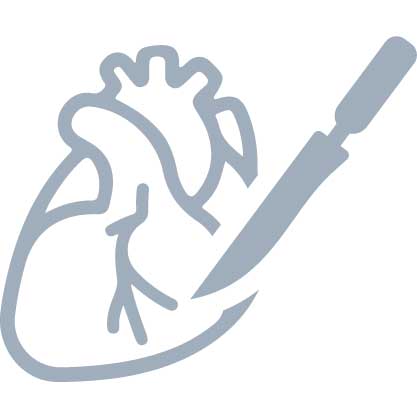Obesity Surgery
BARIATRIC SURGERY
What is bariatric surgery? Why is it performed?
Bariatric Surgery, also known as Weight Loss Surgery, is the common name given to a group of surgical procedures aimed at helping obese patients lose weight. These surgical procedures are among the most effective treatment methods for preventing the life-threatening complications associated with morbid obesity.
The human body records the high weight it has reached as "normal" at a certain stage and programs itself to return to that weight in case of weight loss. Therefore, weight loss achieved through dieting and exercise may not be possible to maintain for a long time for people who remain obese for a long time. At this point, Bariatric Surgery changes the way the body manages nutrients, allowing for the weight loss achieved through a healthy diet and lifestyle changes to be permanent.
PREOPERATIVE PROCESS
On whom is it performed? Is Bariatric Surgery a suitable option for me?The most important criterion used to determine the suitability of Bariatric Surgery for the person is the Body Mass Index, which is directly related to the ratio of fat in the body. (BMI: weight (kg) / height 2 (meters)).According to this criterion;
Patients with a BMI of over 40 (class III obesity)
Patients with a BMI between 35-40 (class II obesity) and additional obesity-related complications such as hypertension, type 2 diabetes, obstructive sleep apnea, heart disease, fatty liver, and osteoarthritis are suitable candidates for bariatric surgery.
The fact that these patients did not receive sufficient response from other non-surgical treatment methods against obesity such as medication, diet and exercise is also among the sought criteria.The criteria are a bit more selective for minors who are obese: In addition to a BMI over 40, at least one obesity-related complication is required for surgical suitability.On the other hand, bariatric surgery is not suitable in some cases such as during pregnancy, in case of drug and high amount of alcohol use, untreated eating disorders and other psychiatric/cognitive problems, as well as the presence of advanced cancer.In addition, detailed specialist examinations and laboratory tests / radiological exams, including extensive blood tests, ultrasonographic imaging, gastroscopy are required to ensure that the person in question is physically and mentally fit for surgery.In some cases, patients may be asked to follow a strict diet before surgery to make the surgical procedure more comfortable and safer. Proper implementation of this diet can also minimize potential post-operative adaptation problems.
SURGICAL PROCEDURE
What are the techniques used in bariatric surgery?Although their techniques differ, all surgical interventions for obesity focus on changing the anatomy and functions of the digestive system (usually the stomach and sometimes the small intestine).
-Main Techniques-
Sleeve Gastrectomy
It is the most frequently perform / most popular bariatric surgery technique because it uses a relatively simple technique and has a lower rate of complication. In Sleeve Gastrectomy, approximately 80% of the stomach is removed and a sleeve shaped stomach is left behind. The reduced stomach volume (approximately 100-150 ml) reduces the amount of potential food intake and makes the person feel full faster. In addition, the decrease in the hunger hormone secreted from the stomach tissue is also effective in maintaining the metabolic balance and blood-glucose balance.It is performed with a minimally invasive technique (laparoscopic, via a few small incisions) and under general anesthesia. The recovery period of this process, which takes about 2-3 hours, is also very short.However, the fact that stomach reduction is irreversible is considered a significant disadvantage. In addition, considering the potential of the stomach to expand, the rate of weight loss may decrease over the years in people who do not change their eating habits.
Gastric Bypass Surgery (Roux-en-Y Gastric Bypass)
It is a technique in which a "short path" is created between the upper part of the stomach and the new stomach pocket and the small intestine which are divided into two different parts, and the food consumed is made to use this path instead of the normal one.It is also called by its original French name “Roux–en–Y” Gastric Bypass due to the resemblance of the formed bowel structure to the letter Y.With this technique, the food passes directly to the forward segment of the small intestine, the length of which is reduced, by using the "short path" without crossing the lower parts of the stomach. Compared to gastric reduction surgeries alone, it is a more effective technique as it both reduces the volume of the stomach and narrows the absorption distance of the small intestine. Co-morbidities related to obesity and Type 2 diabetes are better controlled with this method. However, there is a risk of small intestine complications that are not encountered with the Sleeve Gastrectomy technique and the hospital stay is a little longer. In addition, since vitamin and microelement deficiencies are common in patients, routine health checks and mineral/vitamin supplements are required.
Biliopancreatic Diversion with Duodenal Switch
Duodenal Switch surgery can be defined as a more detailed operation in which Sleeve Gastrectomy and Gastric Bypass surgeries described above are combined. During surgery, the last part of the small intestine is sutured to the surgically reduced gastric sleeve. This way, food travels directly from the stomach to the last part of the small intestine, bypassing the other intestinal sections, and absorption occurs only in this short intestinal segment. As such, much less calories are absorbed compared to before.Although it is very effective in permanent weight loss, it is a technique used less frequently due to an increased rate of early and late complications despite being an effective technique in reducing comorbidities and bringing Type 2 diabetes under control.It is especially preferred for people with super morbid obesity, with a BMI over 50 and for patients who have undergone Bariatric Surgery before but start to gain weight again.
Gastric Balloon
A medical balloon placed in the stomach and inflated with sterile liquid fills a significant portion of the stomach with its volume and creates a feeling of satiety. With this simple technique that does not require surgery, the goal is to achieve approximately 20% of the excess weight to be lost. It should be removed after about 6 months of use. The weight loss is relatively slow compared to the surgical procedures.Nausea and vomiting, foreign body reactions against the implanted object after the procedure are the disadvantages of the technique. However, the important advantages of the technique are that the procedure is reversible thanks to the intact gastrointestinal anatomy, and that vitamin and mineral deficiencies are not observed, since it does not affect the absorption of nutrients.
How to decide which technique to opt for?
The medical team led by the Bariatric Surgeon decides on the most suitable weight loss technique, taking into account factors such as the patient's BMI, clinical and metabolic condition, targeted weight loss, and the patient's preferences.
POSTOPERATIVE PROCESS
Frequently Asked Questions:
Will there be postoperative pain, aches, or incision scars?
Under normal circumstances, all bariatric surgeries are performed laparoscopically. This ensures that the postoperative period is as painless as possible and that the surgical scars are very small.
How long is the recuperation period and how long does it take to return to daily life?
In general, the patient is discharged from the hospital within a day or two and it is possible to return to work within a few weeks. However, strenuous activities should be avoided for up to 6 weeks. Regular follow-ups are especially important in the first year to discover potential nutritional deficiencies.
How should nutrition and exercise be after surgery?
Dietary arrangements approved by the medical team and started before the surgery in some cases, need to be maintained after the surgery. The transition to a normal diet may take up to 2 months in some cases. In addition, exercises deemed appropriate by physicians should be performed regularly as part of a regimen after bariatric surgery.
How much weight can be lost with surgery? Is the lost weight gained back?
Losing approximately half of the excess weight within 12-18 months after surgery and maintaining this achieved weight is an important goal for success. This goal is achieved in almost all bariatric surgeries. In some cases, the ratio of losing the excess weight can reach 80%. Compliance with the planned daily living activities and diet / exercise regimens is important in keeping this weight steady. There is a risk of gradual weight gain starting from the 2nd year after all surgical procedures, especially sleeve gastrectomy, as a result of insufficient exercise and unsuitable nutrition programs and eating habits.
Is it possible to undergo surgery again?
In case of regaining weight after Bariatric Surgery, Revision Surgeries may be required. However, this possibility is very low in patients who follow the exercise and diet programs. In addition, in the presence of sagging skin tissues, which is one of the important complications of rapid weight loss, you may need to consult a specialist for the reconstruction of these tissues 2 years after the surgery.


























